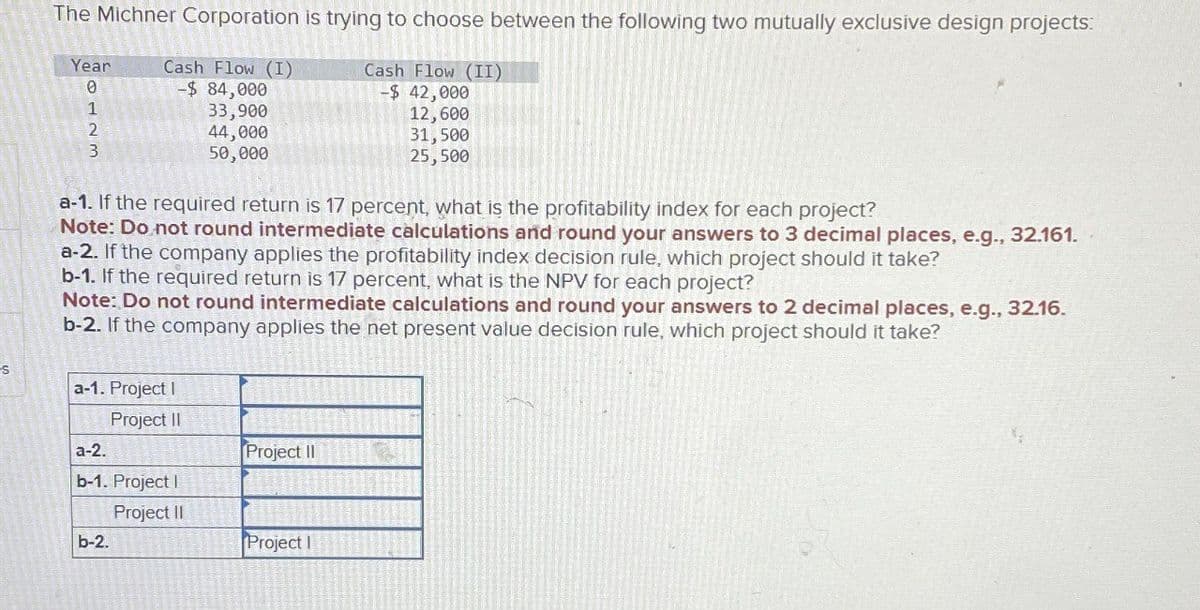The Michner Corporation is trying to choose between the following two mutually exclusive design projects: Year Cash Flow (I) Cash Flow (II) 0 -$ 84,000 -$ 42,000 1 33,900 12,600 2 3 44,000 50,000 31,500 25,500 a-1. If the required return is 17 percent, what is the profitability index for each project? Note: Do not round intermediate calculations and round your answers to 3 decimal places, e.g., 32.161. a-2. If the company applies the profitability index decision rule, which project should it take? b-1. If the required return is 17 percent, what is the NPV for each project? Note: Do not round intermediate calculations and round your answers to 2 decimal places, e.g., 32.16. b-2. If the company applies the net present value decision rule, which project should it take?
The Michner Corporation is trying to choose between the following two mutually exclusive design projects: Year Cash Flow (I) Cash Flow (II) 0 -$ 84,000 -$ 42,000 1 33,900 12,600 2 3 44,000 50,000 31,500 25,500 a-1. If the required return is 17 percent, what is the profitability index for each project? Note: Do not round intermediate calculations and round your answers to 3 decimal places, e.g., 32.161. a-2. If the company applies the profitability index decision rule, which project should it take? b-1. If the required return is 17 percent, what is the NPV for each project? Note: Do not round intermediate calculations and round your answers to 2 decimal places, e.g., 32.16. b-2. If the company applies the net present value decision rule, which project should it take?
Financial And Managerial Accounting
15th Edition
ISBN:9781337902663
Author:WARREN, Carl S.
Publisher:WARREN, Carl S.
Chapter26: Capital Investment Analysis
Section: Chapter Questions
Problem 2CMA: Staten Corporation is considering two mutually exclusive projects. Both require an initial outlay of...
Related questions
Question

Transcribed Image Text:The Michner Corporation is trying to choose between the following two mutually exclusive design projects:
S
Year
Cash Flow (I)
Cash Flow (II)
0
-$ 84,000
-$ 42,000
1
33,900
12,600
2
3
31,500
25,500
44,000
50,000
a-1. If the required return is 17 percent, what is the profitability index for each project?
Note: Do not round intermediate calculations and round your answers to 3 decimal places, e.g., 32.161.
a-2. If the company applies the profitability index decision rule, which project should it take?
b-1. If the required return is 17 percent, what is the NPV for each project?
Note: Do not round intermediate calculations and round your answers to 2 decimal places, e.g., 32.16.
b-2. If the company applies the net present value decision rule, which project should it take?
a-1. Project I
a-2.
Project II
b-1. Project I
Project II
b-2.
Project II
Project I
Expert Solution
This question has been solved!
Explore an expertly crafted, step-by-step solution for a thorough understanding of key concepts.
Step 1: Capital budgeting introduction:
VIEWStep 2: Calculation of the profitability index of each project:
VIEWStep 3: Selection of the Project according to the profitability index decision rule:
VIEWStep 4: Calculation of the net present value of each project:
VIEWStep 5: Selection of the project according to the net present value decision rule:
VIEWSolution
VIEWStep by step
Solved in 6 steps

Knowledge Booster
Learn more about
Need a deep-dive on the concept behind this application? Look no further. Learn more about this topic, accounting and related others by exploring similar questions and additional content below.Recommended textbooks for you

Financial And Managerial Accounting
Accounting
ISBN:
9781337902663
Author:
WARREN, Carl S.
Publisher:
Cengage Learning,

Managerial Accounting
Accounting
ISBN:
9781337912020
Author:
Carl Warren, Ph.d. Cma William B. Tayler
Publisher:
South-Western College Pub

EBK CONTEMPORARY FINANCIAL MANAGEMENT
Finance
ISBN:
9781337514835
Author:
MOYER
Publisher:
CENGAGE LEARNING - CONSIGNMENT

Financial And Managerial Accounting
Accounting
ISBN:
9781337902663
Author:
WARREN, Carl S.
Publisher:
Cengage Learning,

Managerial Accounting
Accounting
ISBN:
9781337912020
Author:
Carl Warren, Ph.d. Cma William B. Tayler
Publisher:
South-Western College Pub

EBK CONTEMPORARY FINANCIAL MANAGEMENT
Finance
ISBN:
9781337514835
Author:
MOYER
Publisher:
CENGAGE LEARNING - CONSIGNMENT

Intermediate Financial Management (MindTap Course…
Finance
ISBN:
9781337395083
Author:
Eugene F. Brigham, Phillip R. Daves
Publisher:
Cengage Learning

